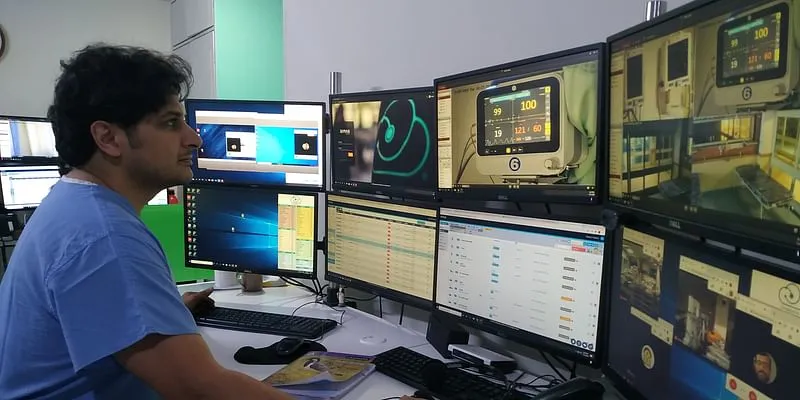How tele-ICU monitoring services are addressing the shortage of ICU specialists in remote areas
Tele-ICU services like Springer Tele-ICU and Cloudphysician are making up for the shortage of intensive care specialists in rural areas with their remote monitoring technology.
A 16-year-old boy was admitted to a hospital in Bihar with severe pneumonia, and his oxygen levels were very low despite him being put on a ventilator. The closest hospital with an ICU specialist team was two hours away in Patna.
“Our team at the command centre used the tele-ICU monitoring RADAR technology to help the nurses at the hospital adopt a treatment that had never been used before at that hospital,” says Dr Dhruv Joshi, director and co-founder of Cloudphysician. “It included laying the boy flat on the stomach and using advanced techniques on the ventilator, bringing up the oxygen levels.”

Tele-ICU monitoring in progress
Three days later, the boy was taken off the ventilator and subsequently discharged from the hospital. He is now back in school. This became possible due to a remote ICU-monitoring service through which an ICU specialist’s advice could be accessed.
Tele-ICU monitoring is a technology that makes up for the shortage of ICU specialists in the country. It helps in providing effective medical care to the patients 24x7, especially during the ongoing COVID-19 pandemic, in remote and rural areas.
SocialStory spoke to two of the leading tele-ICU monitoring services in India - Cloudphysician and Springer Tele-ICU - to understand the benefits of this technology in addressing critical care in remote areas.
Tele-ICU monitoring services
An intensive care specialist is a medical professional trained in the clinical management of critically ill patients as the leader of a multidisciplinary team that looks into various aspects of critical care.
Every year about five million patients require ICU care in India and there are only around 70,000 ICU beds. Less than 15 percent of ICUs have dedicated specialists in the country to meet requirements arising out of COVID-19 pandemic situation and the gap is surging. (NCBI)
Their unique expertise in ICU care is of primary importance in hospital technologies as it requires a super-specialisation course. So the number of such specialists is really low when compared to the demand in many ICUs within a particular city.
“If you look at the data worldwide, ICUs managed by critical care specialists have better outcomes than those managed without expertise,” says Dr Sandeep Dewan, Founder of Springer Tele-ICU.
In remote and rural areas, the ICUs are smaller and are witnessing a severe shortage of specialists. With tele-ICU monitoring, these ICUs can be managed at a much lesser cost.
Cloudphysician
The COVID-19 pandemic has further strained India’s pre-existing shortage of ICU care specialists or intensivists.
Founded by Dr Dileep Raman and Dr Dhruv Joshi, Cloudphysician is addressing the issue through its tele-ICU platform. Its RADAR platform enables an intensivist to cater to the needs of 60 to 80 patients in multiple locations.

Dr Dhruv Joshi at the Cloudphysician command centre
“We started the company in 2017, much before the pandemic broke out, but now our problems have multiplied since the onset of COVID-19,” says Dr Dhruv. “Our focus is to reach out to the hospitals in remote areas.”
The healthtech startup collects patient’s data through real-time audio-visual equipment and internet-connected sensors. It gives hospitals in remote locations access to highly-qualified intensivists and nurses.
Cloudphysician has tied up with Governments of Karnataka and Maharashtra. While its teams worked in several districts in Karnataka, the startup’s biggest deployment was in Mumbai due to the high number of COVID-19 positive cases in the city.
Springer Tele-ICU
Founded by Dr Sandeep Dewan, Springer Tele-ICU enables remote ICU monitoring by using standardised protocols to provide 24X7 monitoring, assessment, and support to patients, using intensive EMR, audio-visuals, and alert systems.
The doctors and nurses at various ICUs are trained in the basic critical care and the ICUs are connected to the main command centre, where a specialist is available.

Dr Sandeep Dewan, Founder, Springer Tele-ICU
“We convert the ICUs into a digital platform and gather the data from ICU devices like the monitor and the ventilator. The data is analysed by the remote specialists after which they advise the doctors and nurses accordingly,” Dr Sandeep says.
Springer Tele-ICU is currently present in 25 districts of India and a few regions in Bangladesh and Nepal. They have tied up with the Governments of Madhya Pradesh, Chhattisgarh, Haryana, and Maharashtra.
COVID-19 impact
Speaking about the impact of COVID-19 pandemic on the tele-ICU services, Ramachandran R, District Collector of Bidar says, “With Karnataka government going for tele-ICU services, even the rural and remote areas now have access to quality care resulting in lower mortality rates. This also cuts down the travel time and need for physical caretaker in the ICU units.”
“We are looking at increasing the tele-ICU units in the state,” he adds.
Both these startups are taking care of numerous COVID-19 patients as well. While Cloudphysician is managing about 300 ICU beds, Springer Tele-ICU is handling 325 beds.
Dr Dhruv says, “The biggest challenge here is the network connectivity. However, with a good connection speed of at least 20 mbps, we are able to transmit our sessions smoothly.”
Funding
ACT Grants is supporting these two startups in carrying out their operations. ACT Grants is a not-for-profit fund created to empower teams that are harnessing technology to create large-scale impact in the detection, prevention, and eradication of COVID-19.
“We have less than 5,000 ICU care specialists in India and quality of care is the single biggest factor in lowering the mortality rate,” says Rachit Parekh from Accel, a volunteer at ACT Grants.

An intensivist monitoring the patients remotely
“To bridge this gap using technology, ACT Grants has partnered with Springer Tele-ICU and Cloudphysician, which are the two leading providers of tele-ICU services in India. ACT is supporting tele-ICUs in 17 districts across five states and is looking forward to help more such projects,” he adds.
While Cloudphysician has received a grant of Rs 19.4 lakh, Springer Tele-ICU has got Rs 45 lakh from ACT Grants.
Journey forward
Cloudphysician says it has taken care of over 10,000 patients and has undertaken one lakh interventions ever since it began its operations across 20 hospitals in eight states.
“Nine out of 10 patients do not have access to ICU specialists. We are aiming to scale our services and add 2,500 beds in the next two years,” says Dr Dhruv, adding, “We want to get to a point where we can manage at least 30,000 patients with our technology.
Springer Tele-ICU has 100 ICU beds in the pipeline, specifically for COVID-19 patients. It says so far it has saved more than 450 lives and treated more than 5,000 patients.
“We plan to expand to all states of India, especially the Tier 2 cities,” says Dr Sandeep. “Our bigger aim is to reach out to the far-flung areas of the country, help more ICUs, and save more lives,” he says.
Edited by Javed Gaihlot









